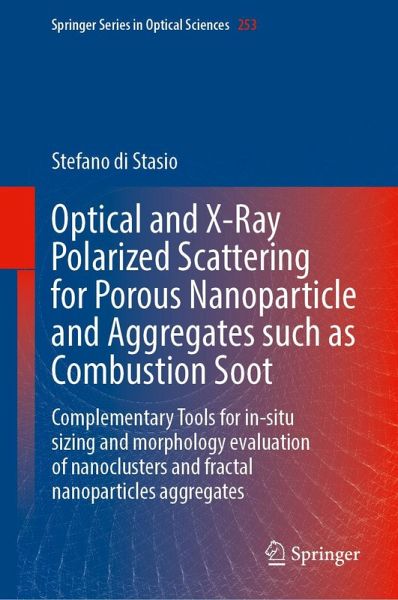
Optical and X-Ray Polarized Scattering for Porous Nanoparticle and Aggregates Such as Combustion Soot
Complementary Tools for In-Situ Sizing and Morphology Evaluation of Nanoclusters and Fractal Nanoparticles Aggregates
Versandkostenfrei!
Erscheint vorauss. 11. September 2025
120,99 €
inkl. MwSt.

PAYBACK Punkte
60 °P sammeln!
Scattering is one of the most powerful techniques for studying objects with size comparable to experimental radiation wavelength without necessity to sampling them, which is called in-situ characterization as opposed to the analysis of microsamples (ex-situ). Aggregates of nanoparticles are one of the most popular media in science and technology. Combustion, thermal decomposition, laser ablation, and plasma reactors are only a few of the methods used to generate particulates aggregated at the nanoscale. This book describes an ideal walk between scattering methods, experimental techniques, and ...
Scattering is one of the most powerful techniques for studying objects with size comparable to experimental radiation wavelength without necessity to sampling them, which is called in-situ characterization as opposed to the analysis of microsamples (ex-situ). Aggregates of nanoparticles are one of the most popular media in science and technology. Combustion, thermal decomposition, laser ablation, and plasma reactors are only a few of the methods used to generate particulates aggregated at the nanoscale. This book describes an ideal walk between scattering methods, experimental techniques, and numerical simulations applied to the study of nanoparticle aggregates. The first part of the book deals with laser light scattering at visible wavelengths. Different approaches using this method are presented, which allows us to gain information about nanoparticle aggregate size, number concentration and morphology without any a priori knowledge about the complex refractive indices of the constituent species. This is particularly relevant for strongly reacting environments in which the chemical composition and microstructure of the nanoparticles are continuously evolving, such as soot in flames. The second part of the book is focused on X-ray


